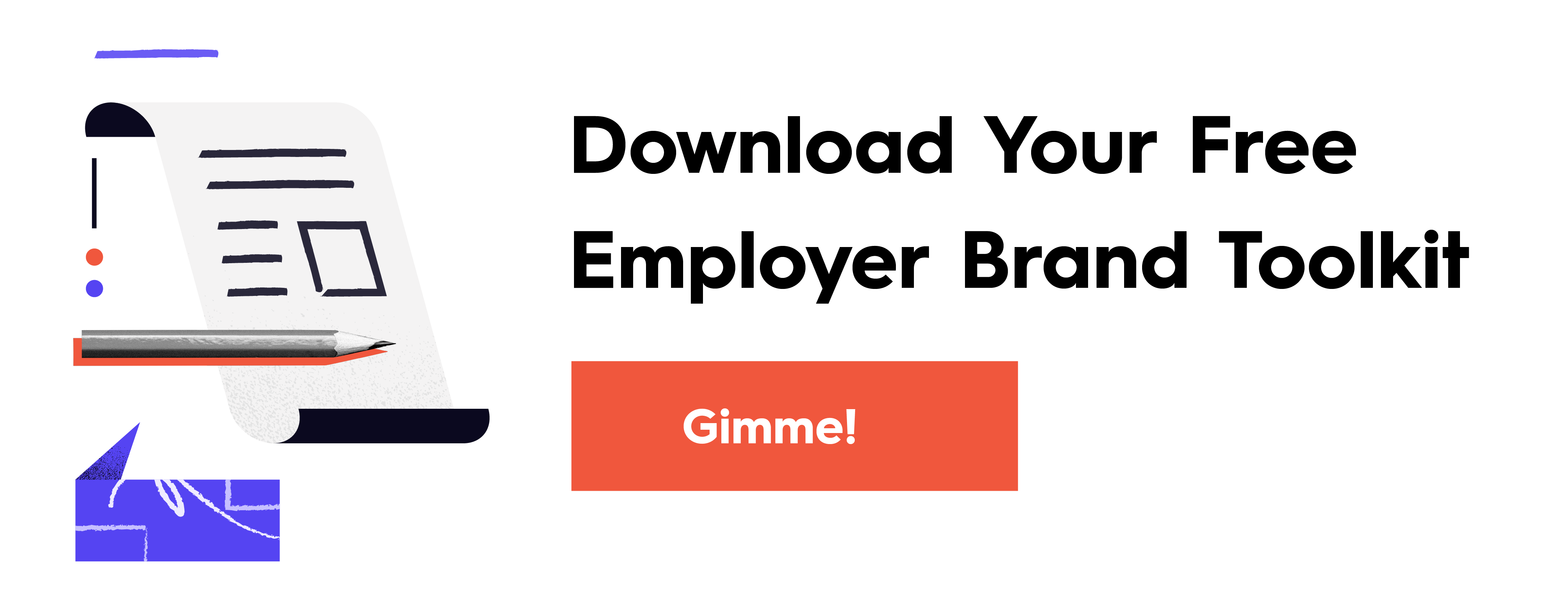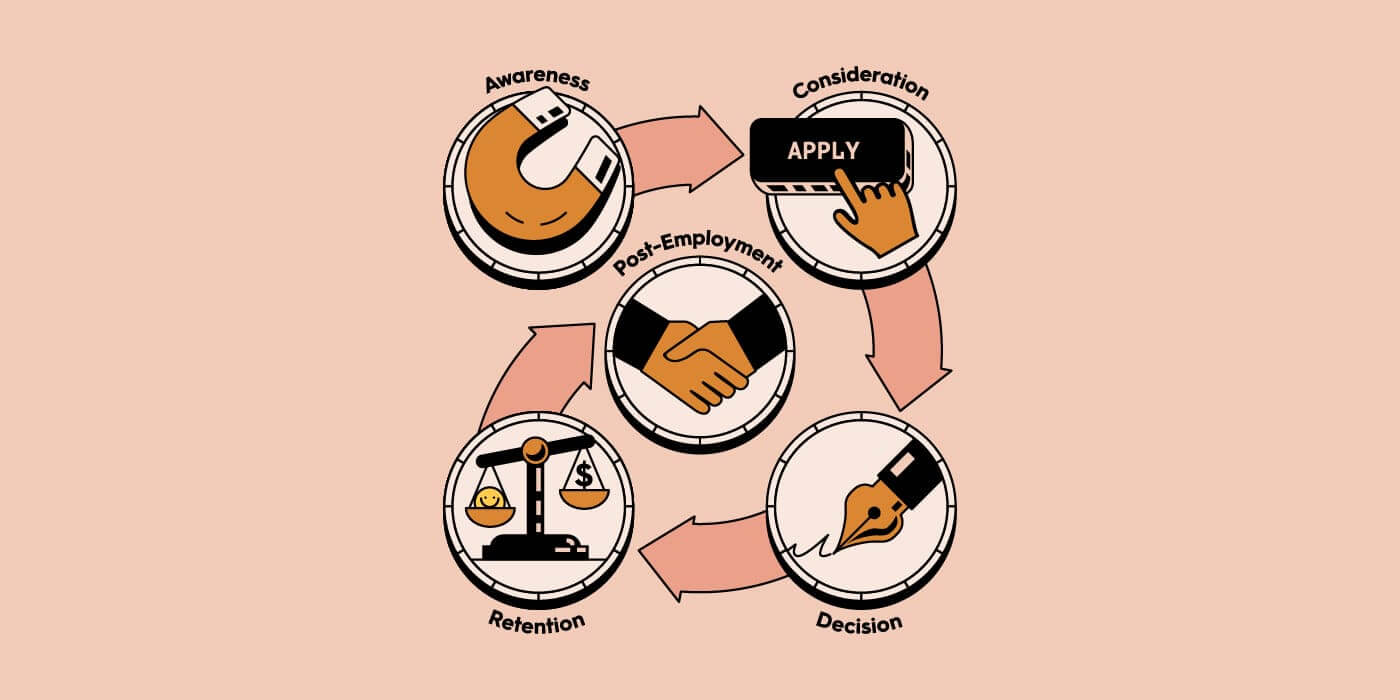Your employer brand is influenced by many things: your culture, your values, your industry, etc. But it is your employee experience that will ultimately make or break you. Whether or not you realize it, the way you treat your employees trickles into every part of your business, from your product development to your customer service. Unhappy, unappreciated, and overworked employees aren’t interested, willing, or able to give their best to anyone. And with no incentive to stay, constant turnover makes it increasingly harder to cultivate a healthy and happy culture.
[bctt tweet=”96% of talent professionals say employee experience is becoming more important.”]
—LinkedIn 2020 Global Talent Trends report
Thus, it’s important to ask yourself: Are you delivering the best employee experience possible? And how do you know what that looks like? Luckily, there’s a simple way to get that insight. Simply map your employee experience and you’ll get the blueprint you need to create a better journey from end to end.
Why Your Employee Experience Matters
To cultivate a strong employer brand, you need to provide a positive, consistent, and cohesive employee experience at every touchpoint—from the first time a potential candidate encounters your brand (even if they’re not looking for a job yet), to the moment they accept the offer, to their final exit interview.
Just like a buyer journey, an employee experience map is a simplified visualization of that employee experience, helping you understand every stage of the journey. At its core, mapping your employee experience is an exercise in empathy, helping you understand what your current employee experience is like, along with key touchpoints, messaging, and insight you need to transform your experience, attract the most talented people, and keep them on board as contributors. Ultimately, it’s the secret to building a better employer brand.
How to Map Your Employee Experience
The good news is that mapping your employee experience journey isn’t as intimidating as it sounds. Here, we’ve broken down the steps and tools you need to get through it as painlessly as possible. (You can probably do it in less than a day if you have the right people and access to the right data.)
Step 1: Identify Your Personas
Your workforce is not a monolith. There are a variety of different people who come to work for you for different reasons. Depending on their unique positions, they will experience your employer brand in different ways. When you go through this process, it is important to complete the mapping exercise through the lens of these different groups.
To do this, create 3-5 personas to represent these different groups, identifying key factors, such as:
- Location
- Job function
- Specialized skills
- Motivators
You’ll also want to distinguish personas by level of leadership, department, or specific subgroup within the company (e.g. Senior Front-End Software Developers).
See our guide to creating marketing personas for relevant tips to build your employee personas.
Step 2: Download the Employee Experience Map Template
To walk you through each phase, we’ve created a free Employee Experience Template. Make a copy for each persona, then work through the following steps with each persona in mind.

Step 3: Analyze Each Stage of Your Employee Experience
The employee journey mirrors the buyer journey. But in this case, people aren’t looking to buy your product; they’re looking to join your company. Still, many of their needs and considerations are the same. Here, you’ll analyze their experience at each stage of the journey, answering questions to help you identify your strengths and weaknesses throughout.
Stage 1: Awareness
Whether they are proactively searching for a new job (an “active candidate”) or fielding a LinkedIn message from a headhunter (“passive candidate”), this is the stage where candidates are exploring their options, learning about open positions, considering the companies they might want to work for, or responding to recruiters.
- What questions are they asking at this stage? These are the questions they have (and thus the info they’re looking for as they research or interact with you).
- Am I as engaged/fulfilled at my current job as I could be?
- Am I ready for a change?
- How do working experiences/growth opportunities at other companies compare to mine?
- What do I want in a job/career?
- What companies are similar to mine?
- What brands do I admire or would I like to explore?
- What else is out there?
- What are your touchpoints? These are your main communication touchpoints—they’re similar to regular marketing channels, with a few tweaks.
- Brand/product marketing
- Broadcast (TV/radio)
- Outdoor (billboards, bus stops)
- Social networks
- Referrals
- Job search platforms
- Direct contact
- Events
- Experiential/guerrilla
- What content will motivate them? This is where you can really influence the employee experience. The better you can tell unique, interesting, and relevant stories about your employer brand, the more you can entice people to consider you and move to the next stage.
- What formats are most dynamic?
- How can you highlight your Employer Value Proposition?
- How will you measure success? While there are qualitative and quantitative metrics to consider, the more specific you are, the easier it will be to gauge success.
- Company profile views (on job search sites)
- Ad click-throughs
- Social followers
- Website visits
Stage 2: Consideration
At this stage, candidates are researching your brand to see if it might be the right fit for them. Beyond your industry, they are looking at what makes you unique: your values, culture, philosophy, track record, etc.
- What questions are they asking at this stage?
- Is this role/department a good fit for me?
- Am I qualified for this open position?
- Am I inspired by this type of work?
- Would I fit in at this company?
- What is the direction of the company?
- Who in my network might have insight about the company?
- What is it really like to work there?
- What are your touchpoints?
- Website (About Page, Culture Page, Job Page)
- Job search and review sites (LinkedIn, Glassdoor, etc.)
- Application
- Confirmation email
- Phone screener
- Interview
- Office visit
- What content will motivate them?
- Brand Heart (purpose, vision, mission, values)
- Benefits highlights (on website)
- Culture content (employee spotlights, explainers, initiatives)
- How will you measure success?
- Number of applicants
- Number of qualified applicants
Stage 3: Decision
During this stage, candidates are making the decision to join the team and go through the onboarding process. Note: What they observe and experience during this phase is especially crucial. It’s important to establish trust, consistency, and transparency from the jump—and to maintain it going forward. Otherwise, they may jump ship quickly. Your interactions at this phase, as well as the expectations you set up, will affect whether or not they can see themselves at the company long term.
- What questions are they asking at this stage?
- Am I ready to leave my current position/situation?
- Does the compensation match my value, needs, and/or future needs (e.g., starting a family)?
- Can I grow with this company?
- Do the work parameters fit around the constraints/demands of my life?
- Does this company seem honest and transparent?
- What are your touchpoints?
- Offer letter
- Offer follow-up (negotiation, feedback, etc.)
- Orientation
- Training materials
- Team intros
- What content will motivate them/make them feel welcome?
- Personalized welcomes from leadership/coworkers
- New hire swag (t-shirts, water bottles, etc.)
- Personalized items (business card, note pads, etc.)
- Welcome kits (for remote hires)
- How will you measure success?
- Acceptance rate
- Time to hire
- Quality hires
- Diversity of candidates
Note: Regular retrospectives help you learn from both your recruiting failures and successes. Take a look at how many qualified candidates you took in, how many you talked to, how many you had for final interviews, how many had the correct skill level or background specified. The more insight you have, the more effective you can be.
Stage 4: Retention
It takes work to bring people into your organization, but this is where you really need to deliver on your employee experience.
[bctt tweet=”Employees with positive experiences are 52% less likely to want to leave their organizations.”] —The Employee Experience Index
Nurturing your people is an ongoing effort, and it requires alignment from top to bottom. Cultivating a healthy culture, promoting your values, and encouraging productive communication are all key to retention.
- What questions are they asking at this stage?
- How does this work environment compare to what I expected?
- Do I like and appreciate my immediate team?
- What are the basics of my role?
- What does success here look like for me?
- How can I support the direction of the company?
- Who will support me in reaching my goals?
- What skills am I able to further develop here?
- Would I recommend a friend work here?
- Do I feel a sense of belonging?
- Do I have unmet needs (growth, engagement, compensation, geographic)?
- Am I properly valued (seen, heard, compensated) by my superiors and peers?
- What are your touchpoints?
- Performance evaluations
- Team-building
- Culture events
- Email, chat apps, intranet
- What content will motivate them?
- Culture
- Initiatives
- Surveys and feedback
- Referral programs
- How will you measure success?
- Employee engagement
- Promotions
- Retention and turnover (voluntary/involuntary)
- Average tenure
Stage 5: Post-Employment
The employee relationship doesn’t end once someone leaves your company. Depending on their experiences, they will remain an advocate for you (and, ideally, send you their high-quality referrals), or they will actively steer people away from you. Thus, the way you handle their exit is just as important as the way you welcome them.
- What questions are they asking at this stage?
- Am I making the right choice to leave?
- What legacy or impact did I leave?
- What skills and relationships will I bring with me?
- Can a continued relationship with this company support my career goals?
- How can I continue to support the company and the people there?
- What are your touchpoints?
- Exit interview
- Social networks
- Company newsletter
- Review sites (Glassdoor)
- Events
- Alumni network
- Direct contact
- What content will help them make the next step?
- Goodbye celebrations
- Parting gifts
- Check-ins post-exit
- How will you measure success?
- Exit interview
- Departures (voluntary/involuntary)
- Willingness to refer
- Alumni referrals
Note: It’s also important to consider where your employees go on their journey when they separate (e.g., freelance, travel, startups, a more challenging role). This data can be useful to identify patterns or figure out why you may be faltering with retention.
Step 4: Turn Your Insights Into Action
Once you’ve documented your employee journey for each persona, you may notice some similar themes, both good and bad. Analyze each journey individually and as a whole to look for areas of improvement.
- What are the strongest and weakest parts of the employee experience journey? You may be good at the decision stage but lackluster in the onboarding stage. Remember: Consistency is key.
- What content works especially well? You may be able to translate success in one area to success in another. If your job descriptions are known for their heart and personality, you may want to revise your onboarding materials to reflect the same.
- What key messages are missing? You want to answer a candidate’s questions before they even have them, but you also want to make sure you’re leading with the right messages. For example, if health and wellness are integral to your culture, how can you infuse that sentiment into your website?
- What content can be improved upon? For example, you might want to add videos to your People page to give candidates a real behind-the-scenes look at your team.
- Are your values consistent throughout the journey? For example, if your product is all about making communication more efficient but you wait three weeks to get back to an applicant, you aren’t following through on your brand promise.
With these insights, you can methodically work to strengthen your employee experience and, by default, your employer brand. To do this effectively, focus on your weakest points first, then work to improve your process as a whole.
The work doesn’t end there, though. Your employee experience is just one part of your employer brand, and there are more things you can do to strengthen it at every level of your organization. For more ideas to get started…
- Clarify your Brand Heart. Your Brand Heart (purpose, vision, mission, values) is the true core of your employer brand. Make sure you have these elements clearly documented and shared with your employees.
- Write your Employer Value Proposition. No matter what the position, you should have a well-defined EVP that communicates your unique benefits and inspires people to learn more. Try these tips to create a more compelling EVP.
- Learn about the keys to a strong employer brand. You can’t just say who you want to be; you have to cultivate the right traits to support your brand.
- Conduct a brand audit. To get valuable feedback about how to improve your employer brand, find out what to ask your potential, current, and former employees.
- Scope your competition. If you want to stand out, you need to know who you’re competing against. Try our simple guide to do a competitive hiring analysis and figure out how to best position yourself.
- Do more culture marketing to bring your brand to life. For more helpful content ideas, find out how to highlight your culture through content.
We realize this is a lot, of course. If you’re overwhelmed, short on resources, or need a little more strategic insight, a creative agency can help you clarify your employer brand story. Follow these tips to find the right one for you, or hit us up. We’re always happy to chat.





